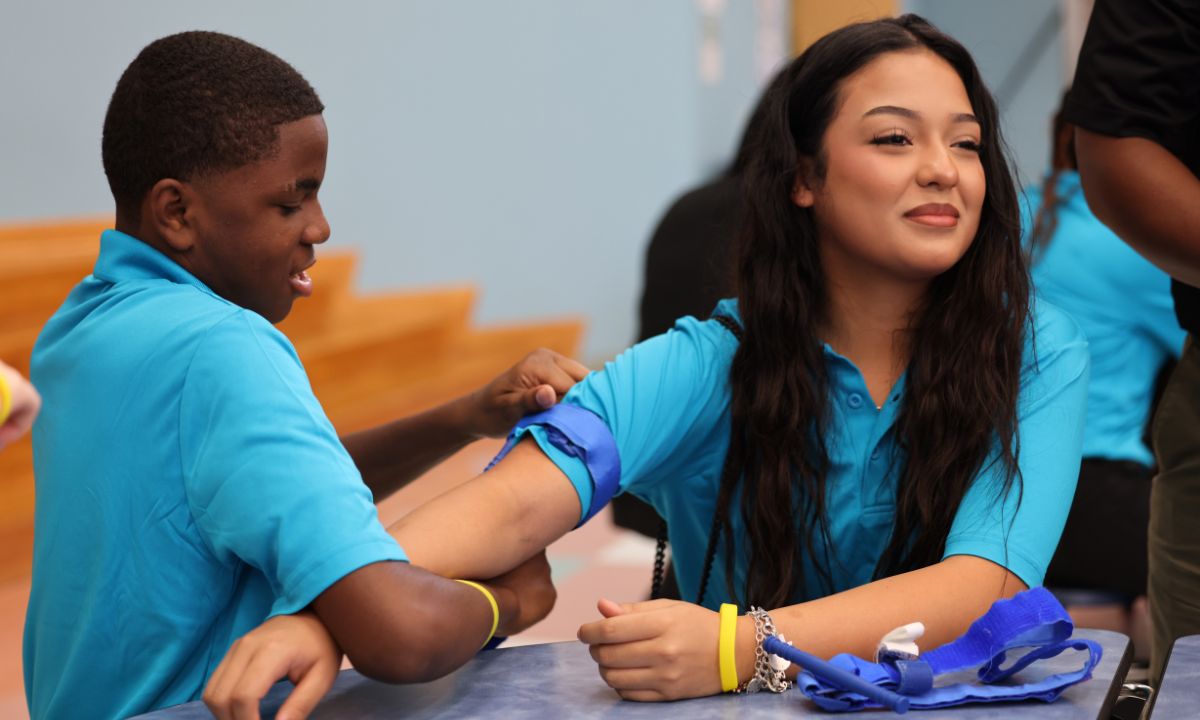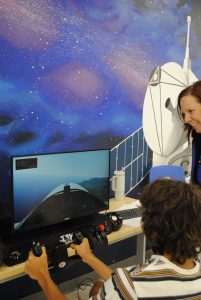The Race to Redefine the High School Learning Experience Is On
Schools are rethinking what students should know by the time they graduate, emphasizing tangible, employable skills, rather than test scores and GPAs.

Get stories like this delivered straight to your inbox. Sign up for The 74 Newsletter
In a few short weeks, Aldine Independent School District in Texas will welcome a new cohort of ninth graders to the HEAL high school programs — one of the biggest career-technical education experiments underway in the state and just one of many that the Houston-area district is implementing to ensure its graduates are equipped with real-world skills.
Through a partnership with Memorial Hermann Health System — the largest health care provider in the Houston area — students pursue one of five pathways, identified for their resistance to automation and urgent local workforce needs: nursing, rehabilitation, pharmacy, imaging, and non-clinical administration.
In ninth and 10th grades, students participate in job-shadowing and practice their skills in simulation labs; starting in their junior year, students have access to paid health care internships and professional mentoring, among other work-based learning experiences. Students at HEAL, or the Health Education and Learning program at Nimitz High School, still take traditional academic courses to meet state graduation requirements, but they also enroll in specialized health care classes co-taught by Memorial Hermann employees.
Once the school is fully phased in over the next three years, it will serve approximately 760 students who will graduate with the skills and in many cases the certifications needed to move directly into high-demand health care jobs with family-sustaining wages.
“We’ve made a big push to re-leverage how we’re using CTE programs and industry-based certificates for kids that are in high-demand, high-wages career fields,” says Adrian Bustillos, the chief transformation officer at the district.
“The hospital system was telling us we have a shortage in these pathways and careers that we need to fill. Well, let’s work with our students sooner so we can get them in today. Give them access to their building, give them access to their training and to the experts in the field, and help cultivate future healthcare workers,” he says. “This is a game changer.”
The 58,000-student school district, where the vast majority of students are from low-income families, offers other workforce pathways focused on cybersecurity, energy, engineering and more — partnering with local businesses to offer students real-world experiences, industry certifications and dual credit opportunities.
Looking ahead, Bustillos says, Aldine is focused on how to make these options available for all students and on how to orchestrate a wholesale shift from a century-old learning model rooted in class time and passing exams to one that prioritizes skills gained.
“How do we find the other premier programs that are rooted in a model similar to this, that students want and the community needs, and that will help drive the market? How can we leverage our thinking and drive it out to scale across the district with different pathways?”
Bustillos is far from the only district leader asking such questions these days. The slow recovery from the pandemic combined — along with the swift integration of artificial intelligence and a workforce that’s increasingly interested in skills and experiences over four-year degrees and pedigrees — has scrambled long-held assumptions of teaching and learning. Faced with a moment that’s forcing the education community to rethink what students should be able to do by the time they graduate, many are attempting to pivot away from test scores, GPAs and essays toward more tangible, employable skills.
Indeed, Aldine is part of a new cohort of two dozen school systems from across the country whose leaders are already pursuing this type of transformation. The Future of High School Network, launched this summer by the Carnegie Foundation for the Advancement of Teaching, aims to establish a “new architecture” for high schools across the country — one that sets ambitious goals for students, offers meaningful, rigorous and engaging learning experiences and uses improved tools to measure and accelerate student progress.
The network is part of a larger effort by Carnegie to redefine the so-called “Carnegie unit,” or what many know as the credit hour. Developed back in 1906, the unit defines the amount of time students need to spend in a course to earn credit toward a high school diploma. More than a century later, it still serves as the basis for calculating credits needed for graduation in many states and school districts. And while it once played an important role in standardizing a fragmented public education system, the time-based system, most agree, has outlived its usefulness.
“There is really broad scale recognition that the current design for the American high school isn’t meeting the needs of young people, isn’t meeting the needs of the economy and probably isn’t preparing young people effectively for participation in civic society,” says Timothy Knowles, president of the Carnegie Foundation. “You layer on top of that the intensity of the economic transition that the nation and the world is in, and it makes a very strong argument for this being an important moment for high school transformation.
“Lots of states are grappling with how you move away from time conflated with learning. The Carnegie unit was our creation and it doesn’t really comport with what we now know about how young people learn,” he says. “Now is a critical moment of opportunity not for tinkering around the edges with small elegant examples but with more sustainable and scalable examples.”
The goal of the high school network is for members to collaborate on a framework that helps other districts modernize their outdated systems and expand competency-based high school models that accelerate student engagement, achievement and success in postsecondary education and work — whether that’s community college, medical school, a certificate program, the military or directly into the workforce.
The cohort is wildly diverse, both geographically and when it comes to the demographics of students the schools serve. It includes traditional public school districts like Aldine, Akron Public Schools in Ohio, Roanoke Public Schools in Virginia and New York City Public Schools; and it incorporates more innovative public and public charter systems like the Rural Alliance Zone in Indiana, and the Springfield Empowerment Zone in Massachusetts.
That wasn’t an accident. If the goal is to pursue high school transformation at scale, then the first step, Knowles says, is to prove that it works in states and districts that look like the rest of the country.
“What is it that Aldine is doing — particularly preparing young people for careers in healthcare — and how does that actually work in a way that would be useful for other systems across Texas, but also anywhere, and then elevating those lessons and building evidence.”
While the programs are unique and, in most cases, speak to the needs of the local workforce, the through-line is the same: an endeavor to equip students with more meaningful learning.

Northeast Academy for Aerospace and Advanced Technologies student Garret Wand explores the flight simulator with Kim Mawhiney, Director of STEM. (J.K. Yezdanian)
In Elizabeth City, North Carolina, students at the Northeast Academy for Aerospace and Advanced Technologies (NEAAT) choose between three science tracks: aviation, computer, and health. All high school courses are honors courses, and the majority of students also take classes at nearby Elizabeth City State University and the College of the Albemarle.
“We were dissatisfied with the opportunities our students had in the region, and decided it was time to do school differently,” says Andrew Harris, CEO of the academy. “We strive to graduate students who are ready for the real world, and that looks quite different than taking a bunch of multiple choice tests or sitting in rows or any of the things that we might have thought about from our own experiences. We try to make sure that students learn through experience.”
Roughly one in three students at NEAAT graduate with a two-year degree, and two out of three finish with at least one year of post-secondary coursework already completed. All students participate in local internships and are encouraged to earn 150 hours of volunteering in the community.
“If I’m going to have heart surgery, it’s important that the surgeon has passed the test,” he says. “But it’s a whole lot more important to me that he can actually perform the surgery and has a history of doing it. We’re trying to make sure our kids can match this sort of technical knowledge with real world experiences.”
Appetite for the academy’s model is overwhelming. What started with 120 students in eighth and ninth has grown a decade later into 760 students in fifth through 12th. If the school had the funding, Harris says, it would expand enrollment by another 500 to establish a pre-K through fourth grade. The school handles enrollment through a lottery system and receives nearly four applications for every open seat.
Carnegie is joined by several nonprofits and philanthropies to support the high school network’s efforts, including the XQ Institute, which has been pushing school leaders to rethink high school and embrace new models of teaching and learning for the last decade.
“We wake up every day thinking about how high school needs to change,” says Keith Dysarz, chief academic officer at XQ. “We have all this data that shows what we’re doing now isn’t preparing students for success when they leave high school.”
For Dysarz, the most important part of the effort isn’t simply dismantling the current model; it’s gathering data and evidence of what works to support the types of policy needed for scalable and sustainable change.
“There’s a lot of momentum in this work across the country right now, and this network is going to help us reimagine and envision new models for high school. We need these proof points, these examples that can turn into exemplars to really show that it’s possible.”
This article was published with the support of XQ Institute.
Disclosures: The Future of High School Network and The 74 both receive financial support from the Carnegie Corporation of New York, XQ and the Walton Family Foundation.
Get stories like these delivered straight to your inbox. Sign up for The 74 Newsletter

;)